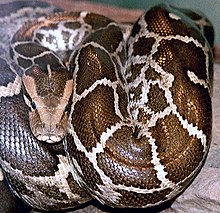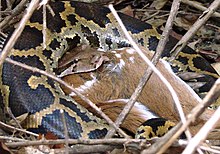Indian python
| Indian python | |
|---|---|

| |
| Scientific classification | |
| Kingdom: | |
| Phylum: | |
| Subphylum: | |
| Class: | |
| Order: | |
| Suborder: | |
| Family: | |
| Genus: | |
| Species: | P. molurus
|
| Binomial name | |
| Python molurus (Linnaeus, 1758)
| |
| Synonyms | |
| |
Python molurus is a large non-venomous python species found in many tropic and subtropic areas of Southern and Southeast Asia. It is known by the common names Indian python,[2] black-tailed python,[3] and Indian rock python. Two subspecies are currently recognized: the nominat subspecies (Python m. molurus) and the Burmese Python (Python m. bivittatus). The nominate subspecies mainly described here is limited to Southern Asia, is generally lighter colored than the Burmese Python and reaches usually 3 metres (9.8 ft)[4].
Common names
Indian python,[2] black-tailed python,[3] Indian rock python, light phase Asian rock python.[5][6] Referred to as "Ajgar" in Hindi.
Description
The color pattern is whitish or yelloish with the blotched patterns varying from shades of tan to dark brown. This varies with terrain and habitat. Specimens from the hill forests of Western Ghats and Assam are darker, while those from the Deccan Plateau and East Coast are usually lighter.[7]
In Pakistan, Indian Pythons commonly reach a length of 2.4 - 3 metres.[8] In India, the nominate subspecies grows to 3 metres (9.8 ft) on average [4][7] This value is supported by a study in Keoladeo National Park, where 1990 the biggest 25 % of the python population was 2.7 – 3.3 metres long. Only two specimen even measured nearly 3.6 metres (12 ft). [9] Because of confusion with the Burmese Python, exaggerations and stretched skins in the past, the maximum length of this subspecies is hard to tell. The longest scientifically recorded specimen hailed from Pakistan and was 4.6 metres (15 ft) in length and weighing 52 kilograms (115 lb).[8]
Geographic range

The nominate subspecies is found in Pakistan, India, Assam, Sri Lanka, southern Nepal, Bhutan, Bangladesh and probably in the north of Myanmar.[10]
Habitat
Occurs in a wide range of habitats, including grasslands, swamps, marshes, rocky foothills, woodlands, "open" jungle and river valleys. They depend on a permanent source of water.[11] Sometimes they can be found in abandoned mammal burrows, hollow trees, dense water reeds and mangrove thickets.[7]

Behavior
Lethargic and slow moving even in its native habitat, they exhibit little timidity and rarely try to escape even when attacked. Locomotion is usually rectilinear, with the body moving in a straight line. They are very good swimmers and are quite at home in water. They can be wholly submerged in water for many minutes if necessary, but usually prefer to remain near the bank.


Feeding
These snakes feed on mammals, birds and reptiles indiscriminately, but seem to prefer mammals. Roused to activity on sighting prey, the snake will advance with quivering tail and lunge with open mouth. Live prey is constricted and killed. One or two coils are used to hold it in a tight grip. The prey, unable to breathe, succumbs and is subsequently swallowed head first. After a heavy meal, they are disinclined to move. If forced to, hard parts of the meal may tear through the body. Therefore, if disturbed, some specimens will disgorge their meal in order to escape from potential predators. After a heavy meal, an individual may fast for weeks; the longest recorded duration being 2 years. The python can swallow prey bigger than its size because the jaw bones are not connected. Morever the prey cannot escape from its mouth because of unique arrangement of the teeth( which is reverse saw like). So far there have been no authentic cases of a human being eaten by this species.[5]
Reproduction
Oviparous,up to 100 eggs are laid, protected and incubated by the female.[11] Towards this end, it has been shown that they are capable of raising their body temperature above the ambient level through muscular contractions.[12] The hatchlings are 45-60 cm (18-24 in) in length and grow quickly.[11]
Conservation status
These snakes have often been killed for their fine skin and are endangered. They are now partly protected by the Tamil Nadu Government. In Kerala and Tamil Nadu, the meat is eaten by locals as the fat is purported to have medicinal value. The Indian Python is classified as Lower Risk/Near Threatened on the IUCN Red List of Threatened Species (v2.3, 1996).[13] This listing indicates that it may become threatened with extinction and is in need of frequent reassessment.[14]
Subspecies
| Subspecies[2] | Taxon author[2] | Common name[5] | Geographic range[6][15] |
|---|---|---|---|
| P. m. bivittatus | Kuhl, 1820 | Burmese python | Eastern India and Nepal into Burma, Thailand, Cambodia, Laos, the northern part of the Malay Peninsula, Vietnam and eastwards to southern China and Hainan. Absent from Borneo and Sumatra, but present on Java, Sulawesi and the small Sunda islands of Bali, Lombok and Sumbawa. |
| P. m. molurus | (Linnaeus, 1758) | Indian python | Pakistan, Nepal, India, Sri Lanka, Bengal, Assam, Bhutan and Bangladesh. |
Taxonomy
In the literature, one other subspecies may be encountered: P. m. pimbura (Deraniyagala, 1945), which is found in Sri Lanka.
Gallery
-
Head scalation.
-
Skeleton.
-
Head
See also
- List of pythonid species and subspecies.
- Pythonidae by common name.
- Pythonidae by taxonomic synonyms.
References
- ^ McDiarmid RW, Campbell JA, Touré T. 1999. Snake Species of the World: A Taxonomic and Geographic Reference, vol. 1. Herpetologists' League. 511 pp. ISBN 1-893777-00-6 (series). ISBN 1-893777-01-4 (volume).
- ^ a b c d "Python molurus". Integrated Taxonomic Information System. 13 September.
{{cite web}}: Check date values in:|date=and|year=/|date=mismatch (help) - ^ a b Ditmars RL. 1933. Reptiles of the World. Revised Edition. The MacMillan Company. 329 pp. 89 plates.
- ^ a b F. Wall: A popular treatise on the common Indian snakes – The Indian Python. Journal of the Bombay Natural History Society Band 21, 1912, p. 447–476; online ab S. 419.
- ^ a b c Jerry G. Walls: "The Living Pythons";T. F. H. Publications, 1998: pp. 131-142; ISBN 0-7938-0467-1
- ^ a b Mark O’Shea: „Boas and Pythons of the World“; New Holland Publishers, 2007; pp 80-87; ISBN 978-1-84537-544-7
- ^ a b c Rhomulus Whitaker: „Common Indian Snakes – A Field Guide“; The Macmillan Company of India Limited, 1987; pp. 6-9; SBN 33390-198-3
- ^ a b S. A. Minton: A contribution to the herpetology of West Pakistan. Bulletin of the American Museum of Natural History Band 134, Heft 2, 1966, p. 117-118; Volltext, pdf.
- ^ S. Bhupathy: Blotch structure in individual identification of the Indian Python (Python molurus molurus) and its possible usage in population estimation. Journal of the Bombay Natural History Society Band 87, Heft 3, 1990, S. 399-404.
- ^ R. Whitaker, A. Captain: Snakes of India, The field guide. Chennai, India: Draco Books 2004, ISBN 81-901873-0-9, p. 3, 12, 78-81.
- ^ a b c Mehrtens JM. 1987. Living Snakes of the World in Color. New York: Sterling Publishers. 480 pp. ISBN 0-8069-6460-X.
- ^ Victor H. Hutchison, Herndon G. Dowling, and Allen Vinegar 1966 Thermoregulation in a Brooding Female Indian Python, Python molurus bivittatus. Science 151(3711):694 - 695
- ^ Python molurus at the IUCN Red List. Accessed 12 July 2009.
- ^ 1994 Categories & Criteria (version 2.3) at the IUCN Red List. Accessed 13 September 2007.
- ^ H. Bellosa, Dr. L. Dirksen, Dr. M. Auliya: "Faszination Riesenschlangen - Mythos, Fakten und Geschichten"; BLV Buchverlag GmbH & Co., 2007: pp 18-23; ISBN 978-3-8354-0282-9
Further reading
- Whitaker R. (1978). Common Indian Snakes: A Field Guide. Macmillan India Limited.
- Daniel, JC. The Book Of Indian Snakes and Reptiles. Bombay Natural History Society
External links
http://www.srilankareptile.com/Serpentes/Species.php
- Python molurus at the Reptarium.cz Reptile Database. Accessed 13 September 2007.
- Indian Python at Ecology Asia. Accessed 13 September 2007.
- Indian python at Animal Pictures Archive. Accessed 13 September 2007.




